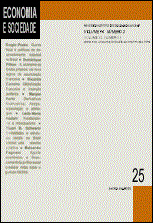Resumo
Neste trabalho, discutimos algumas características peculiares da balança de pagamentos do país que emite a moeda-chave em diferentes padrões monetários internacionais a partir de uma perspectiva sraffiana, na qual a taxa monetária de juros do país central é vista como uma variável independente, determinada institucionalmente. Esta análise breve e esquemática das teorias e experiências dos padrões monetários internacionais nos permitirá atingir o objetivo principal deste trabalho que é o de apresentar uma caracterização simples, porém suficientemente precisa, do atual padrão monetário internacional, que chamamos de “padrão dólar flexível”.
Abstract
In this paper we discuss some essential features of the balance of payments position of the country which issues the key currency in different international monetary standards. The analysis is made from a Sraffian standpoint, where the monetary rate of interest of the central country is seen as an independent policy variable, institutionally determined. This brief and schematic analysis of the theories and experiences of the international monetary standards shall allow us to reach the prime aim of this work, which is that of providing a simple but sufficiently precise characterization of the current international monetary standard, that we shall call the “floating dollar standard”.
Key words: International monetary system. Floating dollar standard. Exogenous rate of interest
Referências
ARRIGHI, G. O longo século XX. Rio de Janeiro: Contraponto, 1996.
BARRO, R. (1979). Money and price level under the gold standard.. Reprinted in EICHENGREEN, B. The gold standard in theory and history. New York: Methuen, 1985.
BELLUZZO, L. Dinheiro e as transfigurações da riqueza. In: TAVARES, M. C., FIORI, J. L. Poder e dinheiro. Rio de Janeiro: Vozes, 1997.
________. Finanças globais e ciclos de expansão. In: FIORI, J. Estados e moedas. Rio de Janeiro: Vozes, 1999.
BIASCO, S. L’inflazione nei paesi capitalistici industrializati. Milano: Feltrinelli, 1979. DeCECCO, M. Money and empire. London: Frances Pinter, 1984.
EICHENGREEN, B. Globalizing capital: a history of the international monetary system. Princeton: Princeton University Press, 1996.
FRENKEL, J., JOHNSON, H. The monetary approach to the balance of payments. Toronto: University of Toronto Press, 1976.
HICKS, J. A market theory of money. Oxford: Oxford University Press, 1989.
HUME, D. (1752). On the balance of trade. Reimpresso em EICHENGREEN, B. The gold standard in theory and history. New York: Methuen, 1985.
KEYNES, J. (1936). The general theory of employment, interest and money. New York: Harcourt Brace Jovanovich, 1964.
KINDLEBERGER, C. International capital movements. Cambridge: Cambridge University Press, 1987. KINDLEBERGER, C. The dollar and world liquidity: a minority view. Reprinted in COMPARATIVE political economy: a retrospective. Cambridge, Mass.: The MIT Press, 2000.
MCKINNON, R. The East Asian exchange rate dilemma and the world dollar standard.
[s.l.]: Asian Development Bank, Feb. 2002. (Mimeogr.).
________. The international dollar standard and the sustainability of the U.S. current account deficit. Presented at BROOKINGS PANEL ON ECONOMIC ACTIVITY: Symposium on the Current Account. Washington, DC: The Brookings Institution, Oct. 2001. (Mimeogr.).
MEDEIROS, C., SERRANO, F. Padrões monetários internacionais e crescimento. In: FIORI, J. Estados e moedas. Rio de Janeiro: Vozes, 1999.
MINSKY, H. Integração financeira e política monetária. Economia e Sociedade, Campinas, n. 3, dez. 1994.
PARBONI, R. The dollar and its rivals. London: Verso, 1981.
PIVETTI, M. An essay on money and distribution. London: MacMillan, 1991.
________. Money endogenity and monetary non-neutrality from a Sraffian perspective.
In: ROCHON, L.-P., VERNENGO, M. Credit, interest rates and the open economy: essays in horizontalism. Aldershot: Edward Elgar, 2001.
POLANYI, K. The great transformation. New York: Rinehart, 1944.
WRAY, L. RANDALL. Understanding modern money: the key to full employment and price stability. Northampton, MA: Edward Elgar, 1999.
SCHULMEISTER, S. Globalization without global money: the double role of the dollar as national currency and world currency. Journal of Post Keynesian Economics, v. 22, n. 3, Spring 2000.
SERRANO, F. Política monetária e a abordagem da taxa de juros exógena. Rio de Janeiro: UFRJ. IE, 2002. (Mimeogr.).
________. Review of Pivetti’s essays on money and distribution Contributions to Political Economy, 1993.
SOLOMON, R. The international monetary system, 1945-1981. New York: Harper & Row Publishers, 1982.
TAVARES, M. C. (1985). A retomada da hegemonia americana. Reimpresso em TAVARES, M. C., FIORI, J. L. Poder e dinheiro. Rio de Janeiro: Vozes, 1997.
TEIXEIRA, A. Estados Unidos: a ‘curta marcha’ para a hegemonia. In: FIORI, J. Estados e moedas. Rio de Janeiro: Vozes, 1999.
________. O ajuste impossível. Rio de Janeiro: Ed. da UFRJ, 1994.
TRIFFIN, R. Gold and the dollar crisis. New Haven: Yale, 1960.
________. O sistema monetário internacional. Rio de Janeiro: Expressão e Cultura, 1972.
A Economia e Sociedade utiliza a licença do Creative Commons (CC), preservando assim, a integridade dos artigos em ambiente de acesso aberto.

